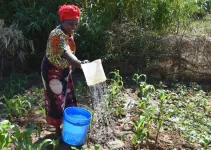(Press-News.org) Water isn't just crucial for life, it's fundamental to increasing opportunities for women and girls in rural areas across the globe. A new Stanford study reveals how bringing piped water closer to remote households in Zambia dramatically improves the lives of women and girls, while also improving economic opportunities, food security and well-being for entire households. The research, recently published in Social Science & Medicine, could spur governments and NGOs to more carefully evaluate the costs and benefits of piped water as an alternative to less accessible communal water sources.
"Switching from the village borehole to piped supply saved almost 200 hours of fetching time per year for a typical household," said study senior author Jenna Davis, a professor of civil and environmental engineering at Stanford and director of Stanford's Program on Water, Health and Development. "This is a substantial benefit, most of which accrued to women and girls."
Globally, about 844 million people live without safe, accessible water for drinking, cooking, cleaning, hygiene and food production - the linchpin of healthy, prosperous communities. Just 12 percent of the rural population in sub-Saharan Africa has water piped to their home. Instead, families collect water from distant, shared sources, with women and girls overwhelmingly responsible for performing the time-consuming and arduous chore of carrying containers that average about 40 pounds each. Dedicating a large chunk of their day to water fetching takes time away from activities such as childcare, housework, hygiene, outside employment, education and leisure.
"Addressing this problem provides the time and water for women and girls to invest in their household's health and economic development, in whatever way they see fit," said lead author James Winter, who recently defended his PhD in civil and environmental engineering at Stanford.
Over the past several decades, national governments and international aid groups have spent hundreds of millions of dollars installing basic water sources, such as wells and handpumps. However, many of these sources are still far from users' homes, resulting in long journeys to fetch water. Previous studies have shown water fetching can harm both mental and physical well-being, while piped water at home can increase water for hygiene and livelihoods, improve food production and decrease infectious disease prevalence.
Yet despite this finding, piped water installations in sub-Saharan Africa have increased by a mere 2 percentage points since 2007. Investing resources into high-quality piped water sources that are dramatically closer to rural households could thus be a more effective route to providing safe, accessible and affordable drinking water for all.
For their study, the researchers examined less frequently measured aspects of well-being - including time savings, economic opportunity and nutritional security - that can be gained through increased access to reliable, easily accessible water. To do this, the team followed four rural villages within Zambia's southern province that had similar populations and access to school, markets and health care facilities. Halfway through the study, two of the villages received piped water to their yard, reducing the distance of their water source to just 15 meters.
Each village was surveyed at the beginning, middle and end of the study, with a team of Zambian interviewers conducting a total of 434 household surveys. They collected information on the time spent fetching water, the amount of water used for domestic tasks (cooking and cleaning) and productive uses (watering gardens, brick making or animal husbandry), and the frequency of these activities. A subset of female respondents wore GPS tracking devices to measure walking speeds and distance to water sources. Water meters were used to validate water consumption information.
The researchers found households with piped water spent 80 percent less time fetching water, representing a savings of close to four hours per week. The vast majority of these time savings accrued to women and girls, confirming that females disproportionately benefit from piped water interventions. These time savings were spent gardening, performing other household chores, caring for children or working outside of the home selling products such as fried buns or charcoal. These families also reported being happier, healthier and less worried.
Water consumption, especially for productive purposes, also increased. Households with piped water were over four times more likely to grow a garden, and garden sizes more than doubled over the course of the study. Furthermore, a larger variety of crops were harvested and households reported both selling and consuming this produce, with plans to expand their crop sales in the coming years.
While the accumulated benefits are impressive, they may actually understate the potential time savings of piped water interventions. At the start of the study, households in all four villages lived just a five-minute walk from their primary water source. On average, rural Zambian households spend about double that time walking to their water source, along with additional time waiting in line and filling water containers. The researchers point out that introducing piped water near homes elsewhere in Zambia could save the average rural household 32 hours per month, which is almost twice the amount of time recouped by households in this instance.
Of course, a piped water infrastructure does have higher upfront costs, which could discourage government and NGO investments. Poverty poses a major barrier when it comes to water access, and with most of the world's poorest countries in sub-Saharan Africa, more research is needed to understand what is needed for communities to sustain piped water networks.
"The benefits we see here make it crucial for future work to understand how these systems can be operated and maintained in a financially sustainable way, even in geographically isolated, rural communities," said Winter.
INFORMATION:
A new paper in Q Open finds that the availability of fast food restaurants on the route between children's houses and their schools does not affect children's weight.
Reducing the rate of childhood obesity is a top public health priority in the United States where obesity rates are 18.4% for those ages 6-11 and 20.6% for those ages 12-19. Childhood obesity is a documented risk-factor for negative physical and mental health outcomes. Obese children are also more likely to become obese adults and suffer associated health problems.
Researchers have proposed that the accessibility ...
Researchers in South Korea have developed a phototherapy technology that can significantly increase efficiency while reducing the pain of chemotherapy and minimizing side effects after treatment. The President of Korea Institute of Science and Technology (KIST), Seok-Jin Yoon announced that a research team led by Dr. Se-hoon Kim at the Theragnosis Research Center (KU-KIST Graduate School of Converging Science and Technology) has developed a cancer-targeted phototherapeutic agent that promises complete elimination of cancer cells without side effects. It involves only one injection and repeated phototherapy. This development ...
While there is an abundant amount of research about traumatic brain injuries in athletes and those serving in the military, the same data is scarce when it comes to concussions and head and neck injuries sustained due to intimate partner violence.
Carrie Esopenko, assistant professor in the Department of Rehabilitation and Movement Sciences in the Rutgers School of Health Professions says that the World Health Organization estimates that one in three women will experience intimate partner violence (IPV) in her lifetime, and studies suggest that anywhere between 30% to 90% of women who experience physical abuse at the hands of an intimate partner experience head trauma. Yet not enough data is being collected to understand how this head trauma affects cognitive and psychological ...
Cities have become the focus of global climate mitigation efforts because as they are responsible for 60-70% of energy-related CO2 emissions. As the world is increasingly urbanized, it is crucial to identify cost-effective pathways to decarbonize and enhance the resilience of cities, which ensure the well-being of their dwellers. In this study, we propose a "SolarEV City" concept, in which integrated systems of cities' roof-top photovoltaics and electric vehicles (EVs) supply affordable and dispatchable CO2-free electricity to urban dwellers.
The SolarEV City assumes that 70% of toof-top of cities at maximum are used for PV and all passenger vehciles are converted to ...
August 2020 set new record high sea surface temperatures (SSTs) in the northwestern Pacific Ocean and around the Japan coasts. A new study led by National Institute for Environmental Studies (NIES) researchers revealed that this warming record could not happen without human-induced climate changes.
The northwestern Pacific sea surface becomes warm seasonally around August every year. However, it was unprecedentedly high in August 2020, according to the Japan Meteorological Agency and the National Oceanic and Atmospheric Administration. The extremely high SSTs exceeding 30°C, which lasted until mid-September, may have intensified tropical cyclones such as ...
At cruising altitude, airplanes emit a steady stream of nitrogen oxides into the atmosphere, where the chemicals can linger to produce ozone and fine particulates. Nitrogen oxides, or NOx, are a major source of air pollution and have been associated with asthma, respiratory disease, and cardiovascular disorders. Previous research has shown that the generation of these chemicals due to global aviation results in 16,000 premature deaths each year.
Now MIT engineers have come up with a concept for airplane propulsion that they estimate would eliminate 95 percent of aviation's NOx emissions, and thereby reduce the number of associated early deaths by 92 percent.
The concept is inspired ...
Tsukuba, Japan -- We laugh when we see Homer Simpson falling asleep while driving, while in church, and while even operating the nuclear reactor. In reality though, narcolepsy, cataplexy, and rapid eye movement (REM) sleep behavior disorder are all serious sleep-related illnesses. Researchers at the University of Tsukuba led by Professor Takeshi Sakurai have found neurons in the brain that link all three disorders and could provide a target for treatments.
REM sleep correlates when we dream. Our eyes move back and forth, but our bodies remain still. This near-paralysis of muscles while dreaming is called REM-atonia, and is lacking in people with REM sleep behavior disorder. Instead ...
Non-invasive imaging technique called 31-phosphorus magnetic resonance spectroscopy used to measure mitochondrial function in patients with motor neuron disease (MND)
Evidence shows that mitochondria - often referred to as the cell's battery - are impaired in MND
This technique could be used to measure the effectiveness of future treatments for MND
Researchers from the Sheffield Institute for Translational Neuroscience (SITraN) have used a new imaging technique to measure the function of mitochondria in patients with motor neuron disease (MND).
The research, published today (13 January 2021) ...
Patients with type 2 diabetes who follow a strict low carbohydrate diet for six months may experience greater rates of remission compared with other recommended diets without adverse effects, suggests a study published by The BMJ today.
The researchers acknowledge that most benefits diminished at 12 months, but say doctors might consider short term strict low carbohydrate diets for managing type 2 diabetes, while actively monitoring and adjusting diabetes medication as needed.
Type 2 diabetes is the most common form of diabetes worldwide and diet is recognised as an essential part of treatment. But uncertainty remains about which diet to choose and previous studies have reported mixed results.
To address this evidence gap, a team of international researchers ...
The build-up of calcium in a major artery outside of the heart could predict future heart attack or stroke, a new Edith Cowan University led study has demonstrated.
Published today in the Journal of the American Heart Association, the research could help doctors identify people at risk of cardiovascular disease years before symptoms arise.
Analysing 52 previous studies, the international team of researchers found that people who have abdominal aortic calcification (AAC) have a two to four times higher risk of a future cardiovascular event.
The study also found the more extensive the calcium in the blood vessel wall, the greater the risk of future cardiovascular events and people with AAC ...



